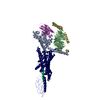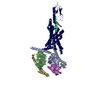[English] 日本語
 Yorodumi
Yorodumi- PDB-7fim: Cryo-EM structure of the tirzepatide (LY3298176)-bound human GLP-... -
+ Open data
Open data
- Basic information
Basic information
| Entry | Database: PDB / ID: 7fim | ||||||||||||||||||||||||
|---|---|---|---|---|---|---|---|---|---|---|---|---|---|---|---|---|---|---|---|---|---|---|---|---|---|
| Title | Cryo-EM structure of the tirzepatide (LY3298176)-bound human GLP-1R-Gs complex | ||||||||||||||||||||||||
 Components Components |
| ||||||||||||||||||||||||
 Keywords Keywords | STRUCTURAL PROTEIN / Cryo-electron microscopy / G protein-coupled receptor / ligand recognition / receptor activation / unimolecular agonist | ||||||||||||||||||||||||
| Function / homology |  Function and homology information Function and homology informationglucagon-like peptide 1 receptor activity / glucagon receptor activity / sensory perception of chemical stimulus / hormone secretion / mu-type opioid receptor binding / positive regulation of blood pressure / corticotropin-releasing hormone receptor 1 binding / post-translational protein targeting to membrane, translocation / G-protein activation / Activation of the phototransduction cascade ...glucagon-like peptide 1 receptor activity / glucagon receptor activity / sensory perception of chemical stimulus / hormone secretion / mu-type opioid receptor binding / positive regulation of blood pressure / corticotropin-releasing hormone receptor 1 binding / post-translational protein targeting to membrane, translocation / G-protein activation / Activation of the phototransduction cascade / Glucagon-type ligand receptors / Thromboxane signalling through TP receptor / Sensory perception of sweet, bitter, and umami (glutamate) taste / G beta:gamma signalling through PI3Kgamma / G beta:gamma signalling through CDC42 / Cooperation of PDCL (PhLP1) and TRiC/CCT in G-protein beta folding / Activation of G protein gated Potassium channels / Inhibition of voltage gated Ca2+ channels via Gbeta/gamma subunits / Ca2+ pathway / G alpha (z) signalling events / High laminar flow shear stress activates signaling by PIEZO1 and PECAM1:CDH5:KDR in endothelial cells / Glucagon-like Peptide-1 (GLP1) regulates insulin secretion / Vasopressin regulates renal water homeostasis via Aquaporins / Adrenaline,noradrenaline inhibits insulin secretion / ADP signalling through P2Y purinoceptor 12 / G alpha (q) signalling events / beta-2 adrenergic receptor binding / G alpha (i) signalling events / Activation of G protein gated Potassium channels / G-protein activation / G beta:gamma signalling through PI3Kgamma / Prostacyclin signalling through prostacyclin receptor / G beta:gamma signalling through PLC beta / ADP signalling through P2Y purinoceptor 1 / Thromboxane signalling through TP receptor / Presynaptic function of Kainate receptors / G beta:gamma signalling through CDC42 / Inhibition of voltage gated Ca2+ channels via Gbeta/gamma subunits / Thrombin signalling through proteinase activated receptors (PARs) / G alpha (12/13) signalling events / Glucagon-type ligand receptors / G beta:gamma signalling through BTK / ADP signalling through P2Y purinoceptor 12 / Adrenaline,noradrenaline inhibits insulin secretion / Cooperation of PDCL (PhLP1) and TRiC/CCT in G-protein beta folding / Ca2+ pathway / Thrombin signalling through proteinase activated receptors (PARs) / G alpha (z) signalling events / Extra-nuclear estrogen signaling / G alpha (s) signalling events / photoreceptor outer segment membrane / G alpha (q) signalling events / G alpha (i) signalling events / spectrin binding / Glucagon-like Peptide-1 (GLP1) regulates insulin secretion / response to psychosocial stress / High laminar flow shear stress activates signaling by PIEZO1 and PECAM1:CDH5:KDR in endothelial cells / Vasopressin regulates renal water homeostasis via Aquaporins / regulation of heart contraction / alkylglycerophosphoethanolamine phosphodiesterase activity / peptide hormone binding / photoreceptor outer segment / D1 dopamine receptor binding / activation of adenylate cyclase activity / adenylate cyclase-activating adrenergic receptor signaling pathway / negative regulation of blood pressure / photoreceptor inner segment / insulin-like growth factor receptor binding / cardiac muscle cell apoptotic process / ionotropic glutamate receptor binding / adenylate cyclase activator activity / G-protein beta/gamma-subunit complex binding / adenylate cyclase-activating G protein-coupled receptor signaling pathway / Glucagon-type ligand receptors / Glucagon-like Peptide-1 (GLP1) regulates insulin secretion / cellular response to catecholamine stimulus / adenylate cyclase-activating dopamine receptor signaling pathway / transmembrane signaling receptor activity / cellular response to prostaglandin E stimulus / G-protein beta-subunit binding / heterotrimeric G-protein complex / sensory perception of taste / signaling receptor complex adaptor activity / positive regulation of cytosolic calcium ion concentration / cell body / GTPase binding / retina development in camera-type eye / Hydrolases; Acting on acid anhydrides; Acting on GTP to facilitate cellular and subcellular movement / G alpha (s) signalling events / phospholipase C-activating G protein-coupled receptor signaling pathway / cellular response to hypoxia / learning or memory / cell population proliferation / cell surface receptor signaling pathway / G protein-coupled receptor signaling pathway / GTPase activity / synapse / dendrite / protein-containing complex binding / GTP binding Similarity search - Function | ||||||||||||||||||||||||
| Biological species | synthetic construct (others)   Homo sapiens (human) Homo sapiens (human) | ||||||||||||||||||||||||
| Method | ELECTRON MICROSCOPY / single particle reconstruction / cryo EM / Resolution: 3.4 Å | ||||||||||||||||||||||||
 Authors Authors | Zhao, F.H. / Zhou, Q.T. / Cong, Z.T. / Hang, K.N. / Zou, X.Y. / Zhang, C. / Chen, Y. / Dai, A.T. / Liang, A.Y. / Ming, Q.Q. ...Zhao, F.H. / Zhou, Q.T. / Cong, Z.T. / Hang, K.N. / Zou, X.Y. / Zhang, C. / Chen, Y. / Dai, A.T. / Liang, A.Y. / Ming, Q.Q. / Wang, M. / Chen, L.N. / Xu, P.Y. / Chang, R.L. / Feng, W.B. / Xia, T. / Zhang, Y. / Wu, B.L. / Yang, D.H. / Zhao, L.H. / Xu, H.E. / Wang, M.W. | ||||||||||||||||||||||||
| Funding support |  China, 7items China, 7items
| ||||||||||||||||||||||||
 Citation Citation |  Journal: Nat Commun / Year: 2022 Journal: Nat Commun / Year: 2022Title: Structural insights into multiplexed pharmacological actions of tirzepatide and peptide 20 at the GIP, GLP-1 or glucagon receptors. Authors: Fenghui Zhao / Qingtong Zhou / Zhaotong Cong / Kaini Hang / Xinyu Zou / Chao Zhang / Yan Chen / Antao Dai / Anyi Liang / Qianqian Ming / Mu Wang / Li-Nan Chen / Peiyu Xu / Rulve Chang / ...Authors: Fenghui Zhao / Qingtong Zhou / Zhaotong Cong / Kaini Hang / Xinyu Zou / Chao Zhang / Yan Chen / Antao Dai / Anyi Liang / Qianqian Ming / Mu Wang / Li-Nan Chen / Peiyu Xu / Rulve Chang / Wenbo Feng / Tian Xia / Yan Zhang / Beili Wu / Dehua Yang / Lihua Zhao / H Eric Xu / Ming-Wei Wang /  Abstract: Glucose homeostasis, regulated by glucose-dependent insulinotropic polypeptide (GIP), glucagon-like peptide-1 (GLP-1) and glucagon (GCG) is critical to human health. Several multi-targeting agonists ...Glucose homeostasis, regulated by glucose-dependent insulinotropic polypeptide (GIP), glucagon-like peptide-1 (GLP-1) and glucagon (GCG) is critical to human health. Several multi-targeting agonists at GIPR, GLP-1R or GCGR, developed to maximize metabolic benefits with reduced side-effects, are in clinical trials to treat type 2 diabetes and obesity. To elucidate the molecular mechanisms by which tirzepatide, a GIPR/GLP-1R dual agonist, and peptide 20, a GIPR/GLP-1R/GCGR triagonist, manifest their multiplexed pharmacological actions over monoagonists such as semaglutide, we determine cryo-electron microscopy structures of tirzepatide-bound GIPR and GLP-1R as well as peptide 20-bound GIPR, GLP-1R and GCGR. The structures reveal both common and unique features for the dual and triple agonism by illustrating key interactions of clinical relevance at the near-atomic level. Retention of glucagon function is required to achieve such an advantage over GLP-1 monotherapy. Our findings provide valuable insights into the structural basis of functional versatility of tirzepatide and peptide 20. | ||||||||||||||||||||||||
| History |
|
- Structure visualization
Structure visualization
| Movie |
 Movie viewer Movie viewer |
|---|---|
| Structure viewer | Molecule:  Molmil Molmil Jmol/JSmol Jmol/JSmol |
- Downloads & links
Downloads & links
- Download
Download
| PDBx/mmCIF format |  7fim.cif.gz 7fim.cif.gz | 218.5 KB | Display |  PDBx/mmCIF format PDBx/mmCIF format |
|---|---|---|---|---|
| PDB format |  pdb7fim.ent.gz pdb7fim.ent.gz | 174.2 KB | Display |  PDB format PDB format |
| PDBx/mmJSON format |  7fim.json.gz 7fim.json.gz | Tree view |  PDBx/mmJSON format PDBx/mmJSON format | |
| Others |  Other downloads Other downloads |
-Validation report
| Summary document |  7fim_validation.pdf.gz 7fim_validation.pdf.gz | 746.7 KB | Display |  wwPDB validaton report wwPDB validaton report |
|---|---|---|---|---|
| Full document |  7fim_full_validation.pdf.gz 7fim_full_validation.pdf.gz | 757.5 KB | Display | |
| Data in XML |  7fim_validation.xml.gz 7fim_validation.xml.gz | 35.2 KB | Display | |
| Data in CIF |  7fim_validation.cif.gz 7fim_validation.cif.gz | 54.2 KB | Display | |
| Arichive directory |  https://data.pdbj.org/pub/pdb/validation_reports/fi/7fim https://data.pdbj.org/pub/pdb/validation_reports/fi/7fim ftp://data.pdbj.org/pub/pdb/validation_reports/fi/7fim ftp://data.pdbj.org/pub/pdb/validation_reports/fi/7fim | HTTPS FTP |
-Related structure data
| Related structure data |  31603MC  7finC  7fiyC  7v35C  7vabC  7vbhC  7vbiC M: map data used to model this data C: citing same article ( |
|---|---|
| Similar structure data |
- Links
Links
- Assembly
Assembly
| Deposited unit | 
|
|---|---|
| 1 |
|
- Components
Components
-Guanine nucleotide-binding protein ... , 3 types, 3 molecules BAG
| #2: Protein | Mass: 39221.090 Da / Num. of mol.: 1 Source method: isolated from a genetically manipulated source Source: (gene. exp.)   |
|---|---|
| #3: Protein | Mass: 45743.441 Da / Num. of mol.: 1 Source method: isolated from a genetically manipulated source Source: (gene. exp.)   |
| #5: Protein | Mass: 7861.143 Da / Num. of mol.: 1 Source method: isolated from a genetically manipulated source Source: (gene. exp.)   |
-Antibody / Protein / Protein/peptide , 3 types, 3 molecules NRP
| #1: Antibody | Mass: 15343.019 Da / Num. of mol.: 1 Source method: isolated from a genetically manipulated source Source: (gene. exp.) synthetic construct (others) / Production host:  |
|---|---|
| #4: Protein | Mass: 68355.688 Da / Num. of mol.: 1 Source method: isolated from a genetically manipulated source Source: (gene. exp.)  Homo sapiens (human) / Gene: GLP1R / Production host: Homo sapiens (human) / Gene: GLP1R / Production host:  |
| #6: Protein/peptide | Mass: 4072.530 Da / Num. of mol.: 1 / Source method: obtained synthetically / Source: (synth.)  Homo sapiens (human) Homo sapiens (human) |
-Details
| Has ligand of interest | Y |
|---|
-Experimental details
-Experiment
| Experiment | Method: ELECTRON MICROSCOPY |
|---|---|
| EM experiment | Aggregation state: PARTICLE / 3D reconstruction method: single particle reconstruction |
- Sample preparation
Sample preparation
| Component | Name: Cryo-EM structure of the human glucagon like peptide 1 receptor in complex with tirzepatide and G protein Type: COMPLEX / Entity ID: all / Source: RECOMBINANT |
|---|---|
| Source (natural) | Organism:  Homo sapiens (human) Homo sapiens (human) |
| Source (recombinant) | Organism:  |
| Buffer solution | pH: 7.4 |
| Specimen | Embedding applied: NO / Shadowing applied: NO / Staining applied: NO / Vitrification applied: YES |
| Vitrification | Cryogen name: ETHANE |
- Electron microscopy imaging
Electron microscopy imaging
| Experimental equipment |  Model: Titan Krios / Image courtesy: FEI Company |
|---|---|
| Microscopy | Model: FEI TITAN KRIOS |
| Electron gun | Electron source: OTHER / Accelerating voltage: 300 kV / Illumination mode: OTHER |
| Electron lens | Mode: BRIGHT FIELD |
| Image recording | Electron dose: 80 e/Å2 / Film or detector model: GATAN K3 (6k x 4k) |
- Processing
Processing
| CTF correction | Type: PHASE FLIPPING AND AMPLITUDE CORRECTION |
|---|---|
| 3D reconstruction | Resolution: 3.4 Å / Resolution method: DIFFRACTION PATTERN/LAYERLINES / Num. of particles: 125391 / Symmetry type: POINT |
 Movie
Movie Controller
Controller


 UCSF Chimera
UCSF Chimera















 PDBj
PDBj














